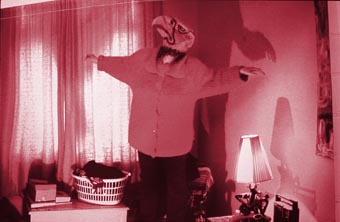Hobart's L-shaped room
Diana Klaosen

Sally Rees, A Loft
LSSp is the cryptic acronym of a new, evolving Hobart studio space catering to some dozen artists and incorporating a much-needed, if very small gallery suited to solo shows—especially installations—not afraid to engage with the unusual (L-shaped) form of the gallery and its limited size.
It is clear on entering the labyrinthine complex (a former senior high school), that LSSp runs on a shoestring budget. This is not a criticism. The bulky doors and stairwells retain their institutional feel, the shared work spaces are identifiable as the classrooms and laboratories of an earlier generation, but when you enter the exhibition space you step into a creative microcosm, a fully-functioning contemporary art space full of constantly changing visual surprises and challenges.
LSSp was established in late 2001 and besides several excellent solo exhibitions, has hosted events including an artist’s residency and an evening of alternative short films to an overflow audience.
Of the solo shows, Conspiratorial Tones, by Samstag scholarship recipient Matt Warren, is part of an extensive multi-faceted on-going work, the absence project, which examines the effect of loss and bereavement in everyday life. Warren’s time-based installation accommodates both the confronting and the contemplative. A red strobe illuminates a video screen, functioning as a kind of closed circuit TV security device, revealing unlovely empty areas of the arts complex. Sequences of blank screen heighten a sense of unease, and a family anecdote involving, implausibly enough, a chair, is delivered as a poignant yet wryly amusing monologue. Warren is a powerful intellect and a masterful video artist, not afraid to examine personal issues in public. His next solo show opens at CAST (Contemporary Art Services Tasmania) on June 7.
By contrast, painter Neil Haddon’s show, Nihil sub sole novum, explores the possibilities of the painted modernist surface, with actual and trompe l’oeil peeling walls, the artist’s distinctive geometric striped acrylic paintings in a palette of colours reminiscent of 50s decor, and props such as pristine paint cans becoming part of a kind of all-enveloping environment that embraces almost the entire gallery space. A crucial, initially imperceptible element of Haddon’s work is that he subverts his apparently systematic colour patterns and meticulously executed perspectival lines, so that the colour sequences are not consistent and the perspective is actually impossible.
Sally Rees’ installation, the punningly titled A Loft is perhaps the most enigmatic and seductive offering to show at the gallery so far. Like a Kafka stage set, the space is arranged as a human scale replica of a budgie cage with outsize mirror, colourful exercise ladder and amusingly large bell, oversized balls of birdseed and a large seed tray. There is something intriguing about the idea of the artist fashioning these bizarre objects, not to mention the possible motivation behind them. It is hard to know if they are meant to be endearing, kitsch, comical or grotesque; they are surreal, certainly.
There is another element to the work: 2 medium scale photographs of—one assumes—the artist in a suburban bedroom, unremarkably clad but for a rubber rooster’s head mask. The sheer eccentricity of this image, the contrived unselfconsciousness of the gestures as the artist poses in very good imitation of a bird springing into flight, is confronting. And again, myriad interpretations are possible, from the grotesquely erotic to the theatrical and more.
The Letitia Street Studio artists group show was held at the new premises of arts@work, an arts advocacy/employment/ promotions body which now shares a building with CAST. Continuing with the esoteric names, this exhibition LSS@arts@work showcases the variety of work being produced at the studios.
Whilst the arts@work organisation has—once again—a small exhibition area, this group show, with 1 or 2 works per artist, was sympathetically hung throughout the complex. Besides the aforementioned artists, the show featured the compelling trademark broken-glass sculptures of Matt Calvert and Shelley Chick’s bizarre and beautiful wall-based lampshade incorporating steel, rubber and play-tiles and decorated with an image of an exotic bird.
Meg Keating’s oil and mica paintings are evocatively titled studies of figures in action, but they transcend the figurative. Her bright, limited palette and ‘marbled’ paint give them a satisfying quasi-abstract edge. Michael Schlitz is an accomplished printer, and his work in this show features more of his sparse gentle monochromatic ‘house style.’ Without advocating novelty for its own sake, I’d like to see something new from this artist.
Also in the show are textile artist Rosemary O’Rourke, painter Anne Morrison, digital artist Troy Ruffles, mixed media sculptor and installation artist John Vella and painter Richard Wastell—all of them significant, emerging Tasmanian talent to watch.
Conspiratorial Tones, Matt Warren, Oct 12-Nov 3, 2001; Nihil sub sole novum, Neil Haddon, Aug-Sept 2001; A Loft, Sally Rees, Nov 3-Dec 9, 2001, LSSp (Letitia Street Space), Hobart.
LSS@arts@work, Group exhibition by LSSp artists, arts@work Gallery Space, Hobart, May 2002.
RealTime issue #49 June-July 2002 pg. 24






